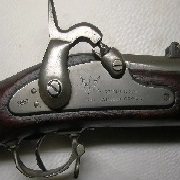|
milhist posts go here, as well as more serious history discussion than (for instance) PYF if you dinks go from friendly disagreement to a fight with real anger in it i will drive to your houses and kick you here's the last installment: https://forums.somethingawful.com/showthread.php?threadid=3785167 HEY GUNS fucked around with this message at 21:52 on Nov 30, 2018 |
|
|
|

|
| # ? Apr 24, 2024 05:19 |
|
I was about to ask this in the HEMA thread when it was on the 30YW topic, but since this one is back open it seems more appropriate here. What's up with this type of sword? To my understanding, it popped up somewhere in the 16th century as a fairly popular sidearm for pikemen? Before that, during the middle ages, the development of swords seemed to trend towards getting longer, pointier, and stabbier. And then all of a sudden you get this short, chunky blade apparently made mostly for hacking, and then just a relatively short time afterwards in the 30YW it seems like everbody's back to stabbier and longer rapiers or sideswords. What circumstances/developments ended up making this apparently fairly unusual kind of sword useful/popular during such a relatively short stretch of time?
|
|
|
|
Perestroika posted:I was about to ask this in the HEMA thread when it was on the 30YW topic, but since this one is back open it seems more appropriate here. What's up with this type of sword? Its called a Katzbalger. More or less its a pure brawling sword. When you couldn't use your pike (or bow/x-bow) you had this. It was more of a block/parry type weapon and hacking. As in, OH poo poo, and beat the gently caress outta a guy with this thing. It was also nicknamed the "dick sword" because it usually hung between the legs and with that crazy hilt... Didn't matter what you were doing as a Landsknecht, this was your backup weapon. EvilMerlin fucked around with this message at 14:31 on Oct 23, 2018 |
|
|
|
I'm reading about the Petersburg siege of 1864-65, and I'd like to ask about how troops destroyed railroad tracks at the time. Like, if you're an infantryman, and you get to a Confederate railroad ... you don't exactly have the right tools to break steel, do you? Would it have been enough to light a fire under/around the track and just whack it out of shape? Did they bring in specialized troops/equipment for this task? Was wrecking the wooden plans between the tracks good enough to damage it? How was it done?
|
|
|
|
gradenko_2000 posted:I'm reading about the Petersburg siege of 1864-65, and I'd like to ask about how troops destroyed railroad tracks at the time. Heat them up enough to bend and wrap 'em around a tree, aka "Sherman's neckties". https://i.imgur.com/DLSBW4C_d.jpg
|
|
|
|
P-Mack posted:Heat them up enough to bend and wrap 'em around a tree, aka "Sherman's neckties". This. It didn't require a lot of effort or people. And booooy oh boy did Sherman's troops piss off the Confeds when they did this. Mostly because they had real issues getting new track to replace the bowties.
|
|
|
|
You can also gently caress then up bad by just taking out all the ties. It’s not as effective but will quickly lead to they track being dangerously unstable. Armies used to have a special car for ripping ties out on a retreat that was basically a plow angled to chop the gently caress out of the ties.
|
|
|
|
Cyrano4747 posted:You can also gently caress then up bad by just taking out all the ties. It’s not as effective but will quickly lead to they track being dangerously unstable. Armies used to have a special car for ripping ties out on a retreat that was basically a plow angled to chop the gently caress out of the ties. Yep, this makes the track unusable but still repairable, which is enough if you're just trying to cover a retreat and buy yourself time. The neck ties make it unusable until you get entirely new rails delivered, which wouldn't have been a problem for the industrial north but was a huge one for the south. It had strategic level effects, especially in Sherman's case where it was tearing out irreplaceable infrastructure vital not just to military movement but the economy as a whole.
|
|
|
|
P-Mack posted:Yep, this makes the track unusable but still repairable, which is enough if you're just trying to cover a retreat and buy yourself time. The neck ties make it unusable until you get entirely new rails delivered, which wouldn't have been a problem for the industrial north but was a huge one for the south. It had strategic level effects, especially in Sherman's case where it was tearing out irreplaceable infrastructure vital not just to military movement but the economy as a whole. This. The South simply couldn't make rail tracks by the late war when Sherman was doing his thing. Burn it, steal it, destroy it. Take away resources. Much the same thing the allies did to the Germans and Japanese in WW2. EvilMerlin fucked around with this message at 15:49 on Oct 23, 2018 |
|
|
|
Milhist relevant: https://twitter.com/AliceAvizandum/status/1054698287448645634
|
|
|
|
faster than infantry, cheaper than cav, and nobody likes 'em
|
|
|
|
HEY GUNS posted:faster than infantry, cheaper than cav, and nobody likes 'em But some of them sure had spiffy uniforms!
|
|
|
|
Cool dragons! Oh, wait.
|
|
|
|
HEY GUNS posted:faster than infantry, cheaper than cav, and nobody likes 'em And also the IFV doesn't offer heavier weapons to support the dismounted troops.
|
|
|
|
Cythereal posted:And also the IFV doesn't offer heavier weapons to support the dismounted troops. Well they do bite harder and kick harder...
|
|
|
|
Gonna make a tachanka/technical tshirt someday.
|
|
|
|
EvilMerlin posted:Its called a Katzbalger. More or less its a pure brawling sword. Cheers! Though I'm also wondering about the "why" as much as the "what". Like, to my uninformed eyes it looks like the shape of European swords developed kinda like this:  And (assuming this observation isn't completely nonsensical  ), I'm wondering why at that particular time and place a relatively short and choppy sidearm was preferred when it was seemingly bookended by longer and stabbier swords on both sides. ), I'm wondering why at that particular time and place a relatively short and choppy sidearm was preferred when it was seemingly bookended by longer and stabbier swords on both sides.
|
|
|
|
Motorized infantry, but the truck poops and is an rear end in a top hat.
|
|
|
|
Perestroika posted:Cheers! Though I'm also wondering about the "why" as much as the "what". Like, to my uninformed eyes it looks like the shape of European swords developed kinda like this: if you like that you'll love cinquedeas
|
|
|
|
Perestroika posted:Cheers! Though I'm also wondering about the "why" as much as the "what". Like, to my uninformed eyes it looks like the shape of European swords developed kinda like this: You ain't wrong. The main reason the Katzbalger became what it became is because if the pike walls. You cannot swing a longsword in those tight brawling quarters, and there was no real use for a sharp point if most of what you were doing in those close quarters was slicing and dicing. Pike armour was typically a chest plate so they went after the upper legs and arms. And the best way to damage those isn't with a thrust, which would piss you off, and not ALWAYS drop you... but a good stout cut/slice from a heavy wide blade? Yeah.... Remember, the rise of the longsword was specifically to counter the advance of armour. And it got to a point (no pun intended) that the longsword was on its way out quickly (1550 for most of Europe, 1570-75 in Germany) because it just wasn't well designed to defeat a soldier in plate, which by the 1500's was affordable to even a simple man-at-arms (note plate armour was LESS expensive than mail, and could, by 1450 be afforded by the middle class warrior, a true man-at-arms, who wasn't nobility or knightly class). We see the rise of the two-handed/bihander/zwihander to defeat the pikes. We see the transition to single handed broadsword/basket swords, as armour slowly fades away...
|
|
|
|
EvilMerlin posted:You ain't wrong. I'm not really sure to start with this, so I've bolded the parts of this that you were correct about. Katzbalgers evolved from 15th century S-hilts, and both longswords and arming swords with similar hilt shapes existed, and were carried by landsknechts and reislaufer. You can also fight with longer swords in "brawls". That's really how armoured fighting was done in the 15th and 16th century fechtbuchs: with long swords. They were largely wrestling matches with your sword acting as a tool to bind, cut, stab, and lever. Consider this early 16th century image from Niklaus Manuel Deutsch: https://commons.wikimedia.org/wiki/File:Niklaus_Manuel_Eidgenosse.jpg I count 6 longswords, some sheathed and some in hand, in the fight on the top frieze. This is not unique to Deutsch, but appears in Urs Graf and Hans Holbein and anyone else you care to list. There are also other swords being used here, notably the schweizerdegen. So this narrative you're presenting of a broad transition to katzbalgers in pike warfare is not viable. Not only were there infantry that were neither landsknecht nor reislaufer but still fought in pike blocks (the tercio comes to mind) even among the Germanic pikemen the katzbalger was not the de facto sidearm of choice. In addition to cut-and-thrust swords (e.g. https://collections.royalarmouries.org/object/rac-object-22924.html) and the degen mentioned above, there are also messers and falchions. Indeed, falchions become especially popular in the mid 16th century, but proceed in use into the 17th. It's also worth observing that even swords that were less specialized in the cut could inflict grievous wounds when swung, so this idea that swords that were geared more toward the thrust were dramatically less effective during "bad war" is not credible. Of the katzbalgers I've found, they can vary considerably in length, but many of them are in line with a late medieval arming sword, around 90-100cm. In general, I don't think you use language well here. I don't find the term "middle class warrior" useful, because "middle class" is a terribly vague term. A man-at-arms, being a heavy cavalryman, would be expected to be armored nearly head to toe in the 15th and 16th centuries, so saying that "even a simple" man-at-arms could afford it reveals you don't really understand your terms. Two handed swords (e.g. the montante) arise well before the adoption of the pike of the weapon of choice of the reislaufer or landsknecht, and their use is not specifically anti-pike, but rather within those regiments they are wielded by the soldiers who protect the banner, which is the most essential command & control tool of a regiment. I do not have a definitive answer for the decline of longswords (though I've found a few 17th century examples so your timeline is off there too), but it is worth noting that you don't see many katzbalgers after the 1560s either. I think this is partly due to transitions in the nature of warfare (increasing number of muskets and wheel-lock pistols), the end of the Italian Wars, and changes in personal protection (the rapier), and very probably fashion as well. Perestroika posted:And (assuming this observation isn't completely nonsensical As I've mentioned above, while the katzbalger was popular for a period of about 70 years, it mainly saw use among a certain class of soldier within a certain cultural millieu, and would have been only a fraction of the swords in use. There were lots of other different styles of sword floating around at the same time. Wider-bladed cutting swords appear in the 17th century as well, such as the aforementioned falchion but also two edged swords like this feller: https://collections.royalarmouries.org/object/rac-object-7032.html. There's no clean linear progression to this stuff.
|
|
|
Oh good we're back, they found a pretty old boat the other day.EvilMerlin posted:But some of them sure had spiffy uniforms! And in the UK everyone involved with light cavalry had a turn being a dragoon! Also, I'm in the middle of the move and oh god so many books why do I have so many!
|
|
|
|
|
How hard is it to use long swords or axes in a shield wall? The Romans started to use longer spathas in shield walls in the Imperial era and the Vikings did it too.
|
|
|
|
I was just reading about an ancient Korean tribe that used 2-person pikes. It’s mentioned in an ancient Chinese source that basically just leaves it at that; does this sound in any way practical? Any other examples of weapons like that that we know more about?
|
|
|
|
ChubbyChecker posted:How hard is it to use long swords or axes in a shield wall? The Romans started to use longer spathas in shield walls in the Imperial era and the Vikings did it too. It's possible as long as you're not all bunched up (i.e. with interlocking shields).  LARP LARP anecdote but a common think newbies who think they are badass vikings do is form a shield wall against all possible threats, before getting stabbed to death piecemeal while being unable to fight back due to how close they are packed in. anecdote but a common think newbies who think they are badass vikings do is form a shield wall against all possible threats, before getting stabbed to death piecemeal while being unable to fight back due to how close they are packed in.
|
|
|
|
It might have been the Nazi supervisor of civilian affairs who deliberately sabotaged the roundup of Jews in Denmark, not out of any particular love for Jews but to avert potential strikes or an uprising:BBC posted:A key priority for Best, as the Third Reich's plenipotentiary in Denmark, was to maintain the flow of agricultural goods from Denmark to Germany. Not for nothing was Denmark known as "Germany's pantry" and as the "whipped cream front" - by some estimates it supplied up to 15% of Germany's needs.
|
|
|
|
GotLag posted:It might have been the Nazi supervisor of civilian affairs who deliberately sabotaged the roundup of Jews in Denmark, not out of any particular love for Jews but to avert potential strikes or an uprising:
|
|
|
|
HEY GUNS posted:counterintuitively i really like people who do the right things for the wrong reasons At a certain point you have to accept that as long as good is done it doesn't matter so much why it is achieved.
|
|
|
|
For a second I thought it was a FW-190 and got bummed out. Turns out it was a AT-6 Texan. Which makes painting it in Luftwaffe markings kinda weird.
|
|
|
|
Hunt11 posted:At a certain point you have to accept that as long as good is done it doesn't matter so much why it is achieved. I think if you don't accept that in history, people and states mostly do good things for the wrong reasons, or at least selfish reasons, you're just giving ammo to people that actively want to do the wrong thing for the wrong reasons. See for example how Lost Causers will point fingers about how Lincoln only freed the slaves as a wartime measure. Yes and? Northern victory still led to emancipation and the 13th-15th amendments. The Union not being moral paragons doesn't mean the Confederacy wasn't loving awful. But it will get twisted that way to push a narrative.
|
|
|
|
I'm wary of giving Best specifically credit because he was an utter piece of poo poo who was a major Gestapo member, oversaw the Night of the Long Knives, and rounded up a fuckton of French Jews even if he let the Danish ones off the hook for purely pragmatic reasons. He was an avid believer in all the racial theories of the Nazis. He was a real lovely person even by the standards of his time, whereas someone like Lincoln who might look bad today at least has the excuse of being born and raised in a world that pushed poo poo ideology onto them and still managed to be a progressive compared to contemporaries. Best doesn't. Yes, it is good that he let the Danes off. But I just don't feel comfortable praising one of Reinhard Heydrich's deputies for pretty much anything.
Crazycryodude fucked around with this message at 00:21 on Oct 24, 2018 |
|
|
|
Geisladisk posted:For a second I thought it was a FW-190 and got bummed out. Turns out it was a AT-6 Texan. Which makes painting it in Luftwaffe markings kinda weird. Gotta get stunt planes for movies and airshows from somewhere, my dude.
|
|
|
|
Glad to see we have another thread because 
|
|
|
|
For anyone just joining us, I translate articles about tanks and tank accessories. In theme with the thread, here's a tank destroyer. M56 Scorpion Queue: Scorpion, SKS, Australian Centurions in Vietnam, PzIII Ausf. E and F, PzIII Ausf. G and H, Trials of the PzIII Ausf. H in the USSR, PzIII Ausf.J-N, Russian Renault, Nashorn/Hornisse, Medium Tank M4A2E8, P.1000 and other work by Grotte, KV-100 and KV-122, Cruiser Tank Mk.I, Cruiser Tank Mk.II, Valentine III and V, Valentine IX, Valentine X and XI, 7TP and Vickers Mk.E trials in the USSR, Modern Polish tank projects, SD-100 (Czech SU-100 clone), TACAM R-2, kpúv vz. 34, kpúv vz. 37, kpúv vz. 38, IS-1 (IS-85), IS-2 (object 240), Production of the IS-2, IS-2 modernization projects, GMC M8, First Soviet assault rifles, Stahlhelm in WWI, Stahlhelm in WWII, SU-76 with big guns, Panther trials in the USSR, Western spherical tanks, S35 in German service, SU-152 combat debut, 57 mm gun M1, T-34 applique armour projects Available for request:  Schmeisser's work in the USSR Object 237 (IS-1 prototype) SU-85 T-29-5 KV-85 Tank sleds T-80 (the light tank) Proposed Soviet heavy tank destroyers DS-39 tank machinegun MS-1/T-18 Kalashnikov's debut works MS-1 production Kalashnikov-Petrov self-loading carbine SU-76M (SU-15M) production S-51 SU-76I T-26 with mine detection equipment IS-2 mod. 1944  Archer Challenger I  Medium Tank M3 use in the USSR HMC T82 Medium Tank M4A4 Hellcat Jagdpanzer IV Grosstraktor Gebirgskanone M 15 Maus development in 1943-44 German anti-tank rifles Panzer IV/70 Czech anti-tank rifles in German service Hotchkiss H 39/Pz.Kpfw.38H(f) in German service  Hotchkiss H 35 and H 39 FIAT 3000 FIAT L6-40 M13/40, M14/41, M15/42 Carro Armato P40 and prospective Italian heavy tanks NEW  Experimental Polish tanks of the 1930s Trials of the LT vz. 35 in the USSR
|
|
|
Jobbo_Fett posted:Glad to see we have another thread because Can Cyrano just post that excellent post about how media no matter how sincere or authentic will always feel slightly off so it can just be enshrined in the OP forever? that was a good post.
|
|
|
|
|
Relatedly, can we get the last thread goldmined too? There's a lot of posts that it'd suck to lose. Would be nice to have links to them in the OP like last time too: https://forums.somethingawful.com/showthread.php?threadid=3297799 https://forums.somethingawful.com/showthread.php?threadid=3585027 https://forums.somethingawful.com/showthread.php?threadid=3785167
|
|
|
|
Yeah just delete the last 5-6 pages and gold mine the rest thanks.
|
|
|
|
|
I have a kind of general question: how did new swords get developed? Like obviously when it's time to actually make them a blacksmith does it, but who's the guy that figures out "if the sword is curved more it'll be more effective at slashing and against the armor and weapons in this time period this width and length would best" and how does that guy go about figuring it out? Did the roman empire have a military R&D department? When a dude had a new idea about how a sword should be shaped, how would that guy go about convincing an army to manufacture enough of those swords to outfit a bunch of soldiers and use an unproven weapon in battle to see if it works? Were there mock fights to help test different blade shapes?
|
|
|
|
A bar i regular was playing this on the TV and i thought this thread would appreciate it. https://www.youtube.com/watch?v=s3gCtS3d7hw I have no clue about its history or reference other than that looks like Napoleon.
|
|
|
|

|
| # ? Apr 24, 2024 05:19 |
|
ninjewtsu posted:I have a kind of general question: how did new swords get developed? Like obviously when it's time to actually make them a blacksmith does it, but who's the guy that figures out "if the sword is curved more it'll be more effective at slashing and against the armor and weapons in this time period this width and length would best" and how does that guy go about figuring it out? Did the roman empire have a military R&D department? When a dude had a new idea about how a sword should be shaped, how would that guy go about convincing an army to manufacture enough of those swords to outfit a bunch of soldiers and use an unproven weapon in battle to see if it works? Were there mock fights to help test different blade shapes? I'm no expert but I know Patton designed a cavalry sword for the US Army in the interwar period. Presumably he was selected for to his long experience and social standing. I'm guessing his getting and cavalry experience informed whatever changes he made to the design.
|
|
|


































